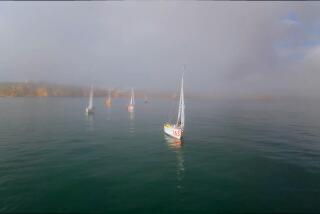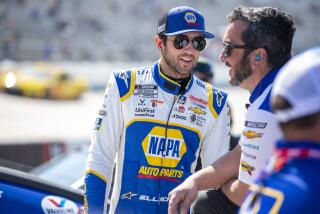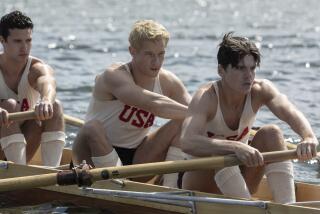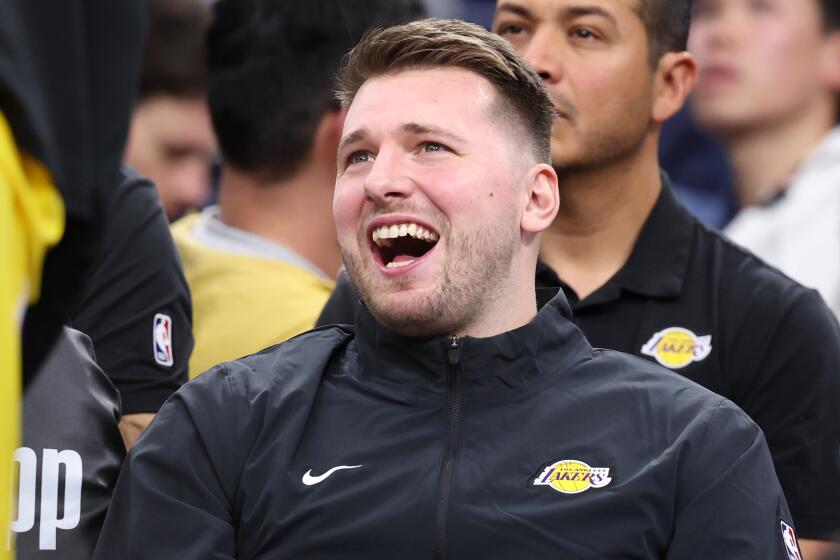Starting a Cup Race Is the End for Some
- Share via
SAN DIEGO — It would be like Mario Andretti taking over for A.J. Foyt or Chris McCarron swapping places with Eddie Delayhoussaye.
The end result of a sailboat race is no different then that of the Indianapolis 500 or the Kentucky Derby. Get the horse, car, boat, (fill in the blank) across the finish line before the other horse, car, boat.
The start, however, certainly is.
In America’s Cup sailing, he who starts the race isn’t always the same one who finishes it, not unlike a relief pitcher or a backup quarterback. Except those guys aren’t on the field the whole game.
Dave Dellenbaugh, America 3’s starting helmsman and tactician is the Bo Jackson of sailboat racing.
But Bo don’t know boats.
When A3 lines up against Il Moro di Venezia Saturday for Race 1 of the 28th America’s Cup final, Dellenbaugh will switch hats shortly after Bill Koch’s white boat crosses the starting line, and hand the wheel to Buddy Melges.
Unlike the Italians, who will use skipper Paul Cayard in that capacity for the duration of the 20.03 nautical-mile race, Koch has implemented a musical chairs afterguard that has successfully landed the syndicate in the finals of the world’s premiere regatta.
“It’s not common in other match-racing,” said Dellenbaugh, who explained that in most yacht racing, a small crew makes it impractical to use more than one sailor at the helm. “But it’s not uncommon in the America’s Cup. The French did it. In Fremantle in 1987, Peter Gilmour was the starting helmsman and Iain Murray took over on Kookaburra (III). It’s not that unusual.”
Marc Bouet started for Ville de Paris then left the driving to Marc Pajot after the opening gun sounded, and worked well enough to get the French to the challengers’ semifinals.
Like anything, there are advantages and disadvantages.
“You can argue both ways, and I think you’d come out even,” Dellenbaugh said. “There is some cost to trading off. At some point, the transition from one (skipper) to another can be tricky. But there may be a gain because I can focus on the start and that frees Buddy up to analyze things that will be coming up ahead of us.”
Stripped of its vast complexity, the purpose of the starting sequence, which begins 15 minutes before the starting gun, is to pick a side of the course you want and to do anything in your power to get there before your opponent can trip you up.
“Basically, you’re circling around to try and get a little better position,” Dellenbaugh said. “Either you like the left or the right side, and you do what you have to do to get to the side you want. It comes down to who has good timing and boat handling.”
Dellenbaugh downplayed the importance of speed to the start. Instead, he likened the strategy of the start to a chess game.
“Move by move, you’re thinking about how you’re going to get in control, how to block the other boat, which way to tack,” he said.
Quick reflexes and a plethora of experience don’t hurt, either. “It helps to have a mental picture of what you’ve seen done before and what you yourself have done in different situations.”
Much ado has been made about the start, so much that New Zealand used the significance of the start to explain away its controversial skipper change during the Kiwis’ two crippling losses to Il Moro in the Louis Vuitton Cup finals.
“I won’t hypothesize about that,” Dellenbaugh said. “What happened, happened, it’s not that what the Kiwis did was right or wrong.”
What he did say was over the course of a three-hour race, there’s usually plenty of time to make up for any minor blunders that occur at the start.
“Even if one boat has an advantage at the start, it’s not the whole race by any means. It’s still just the beginning,” he said, adding that wind conditions often determine whether you can get back into a race or not. “When you have a real steady breeze, it’s hard for a boat behind to come back, especially if their boat speed is even. So if you can start ahead then, it’s fairly important.”
Since Dellenbaugh’s main gig is as A3’s tactical expert, his interest in driving is limited to the start. He has no problem yielding control of the wheel to Melges as soon it’s necessary, or possible.
“I like the tactics role, that’s what interests me,” he said. “I’d do OK steering, but there are people who are much better at it. I have no problem getting off the steering. I’ve actually turned it over to Buddy early, so he can get the feel of it as soon as possible. There’s no sense in staying on the wheel when I can be doing other things.”
Like a batter studies pitching styles, America 3 has studied Cayard, and complied a lengthy profile so the afterguard can better prepare for its showdown off Point Loma.
“The last few days we’ve actually had one boat attempting to duplicate his style, and having the other boat going against it,” said sailing coach Graham Hall. “It’s just like a football game. You prepare for a style, then if they change it, you have to deal with it.”
Whatever Il Moro comes out with, Dellenbaugh is prepared to meet a well-prepared and finely-tuned Cayard.
“He’s had some pretty good starts lately, but he’s been good all along. He just has a good all-around sense . . . I think every start you see next week is going to be exciting.”
More to Read
Go beyond the scoreboard
Get the latest on L.A.'s teams in the daily Sports Report newsletter.
You may occasionally receive promotional content from the Los Angeles Times.










